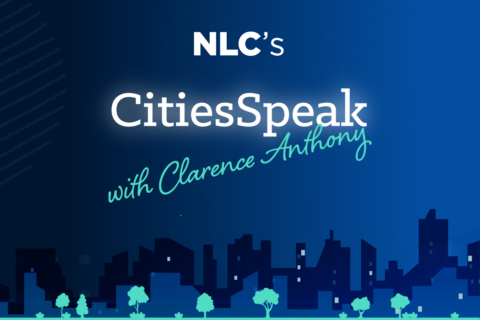*The author recognizes that different people identify with different terminology. The rest of the blog will use the term Hispanic/Latinx to refer to those who identify as Hispanic, Latina, Latino or Latinx in the spirit of brevity. This by no means is an indication of what NLC thinks is the right terminology. Everyone decides what best defines them.
The Hispanic/Latinx population is one of the fastest growing in the United States, rapidly becoming a driving force in the U.S. housing market.
Hispanic/Latinx homeownership rates have consistently increased over the last seven years, due in part to decreases in poverty rates, gains in educational attainment, and a young population — the median age for Hispanic/Latinx people is 30, the lowest among non-Hispanic/Latinx white, Black, and Asian people — approaching homebuying age. The Urban Institute projects this growth to continue, estimating that 70 percent of new homeowners between 2020 and 2040 will be Hispanic; however, gains may not be even among the Hispanic/Latinx population. In 2019, the Afro-Latino homeownership rate was 41.8 percent while Hispanic/Latinx people of Guatemalan, Dominican and Honduran descent had a homeownership rate below 32 percent.
Despite recent gains, Hispanic/Latinx homeownership rates still trail those of the non-Hispanic white population. The Latinx population has a homeownership rate of 51 percent while the homeownership rate for non-Hispanic white residents is 72 percent. This disparity is partly the result of mortgage financing rules that disadvantage Hispanic/Latinx applicants, down payment requirements and predatory lending practices that disproportionately impact people of color. Hispanic/Latinx people are also self-employed at higher rates, are more likely to lack sufficient credit history and work in unstable industries. These characteristics can make securing mortgages difficult, and Hispanic/Latinx people may be rejected for mortgages at higher rates and face higher interest rates than non-Hispanic white applicants.
Hispanic/Latinx households face specific barriers to stable renting and homeownership. For example, linguistic barriers and social security number requirements for mortgage qualifications can discourage newer Hispanic/Latinx immigrants from participating in credit systems or rental assistance programs. The COVID-19 pandemic heavily impacted industries with higher proportions of Hispanic/Latinx workers, exacerbating housing instability by causing income losses that could impact residents’ abilities to make rent and mortgage payments. While Hispanic/Latinx homeownership rates may have increased during the pandemic, the expiration of eviction prevention and rental assistance programs created instability among many renters.
With the legacies of discriminatory wealth-building measures such as redlining still impacting Hispanic/Latinx people today, increasing housing stability and accessibility among this growing population is key to equitable housing practices.
Existing Practices
There are several cities that are already working to support Hispanic/Latinx housing. Below are some of the programs that cities have implemented to engage Hispanic/Latinx residents and support their capacity to secure and maintain housing.
Support for homeowners
Down payment assistance programs have been shown to help increase Hispanic/Latinx homeownership and renter stability.
Fresno, CA designed a first-time homebuyer program tailored for their Hispanic/Latinx community, Llaves De Tu Casa Iniciativa. Launched in 2021, the program aimed to combat myths about the homeownership process and increase the capacity of Hispanic/Latinx families to build wealth through homeownership. This program included down payment and closing cost assistance, homebuyer grants, and first-time homebuyer workshops and educational sessions offered in Spanish. The city’s partnerships with Union Bank, FHLBank San Francisco, and other funders helped make up to $28,000 available to program participants for closing costs and down payment assistance.
Support for renters
Cities across the nation also created strategies to disburse federal funds for rental assistance during the COVID-19 pandemic, which can be a powerful tool for improving housing stability.
Chicago, IL is one city that approached their Emergency Rental Assistance Program through a racial equity lens to increase Hispanic/Latinx participation. Noting that COVID-19 disproportionately impacted Black and Hispanic/Latinx residents, the program aimed to overcome language barriers and government mistrust in these communities.
To make the program more accessible, Chicago produced flyers, applications, and webpages in both English and Spanish and worked with Chicago Public Schools, local community organizations, and Spanish-language news organizations to perform outreach and publicize the program. Chicago also revised communication materials to make clear that funds were available to tenants regardless of immigration status and allowed incomplete application submission, working with applicants to rectify any issues. Chicago’s efforts resulted in a 26 percent increase in the share of Hispanic/Latinx applicants in prioritized communities.
Improving Accessibility for Residents
Language barriers and government distrust can push Hispanic/Latinx residents away from engaging with government systems and programs, making it difficult for officials to meet their needs.
Bloomington, IN’s Latino Outreach Program aims to increase engagement and collaboration between the city and Hispanic/Latinx residents. Founded in the mid-1990s, the program is run by a bilingual staff who communicates between the city’s Commission on Hispanic and Latino Affairs and community organizations. Staff provide referrals, interpretation and translation services to Spanish-speaking residents seeking government or community resources. The program also produces Boletin Comunitario, a monthly Spanish language publication with information on available services, programs, and other topics of interest. The Latino Outreach Program aims to help Hispanic/Latinx residents feel comfortable in Bloomington and bridge the gap between the government and residents.
What Can Cities Do Going Forward?
Cities must develop a deep understanding of the barriers that Hispanic/Latinx households face to stable housing and homeownership, and design targeted programs and policies that take them into considerations. Below are recommendations for cities that aim to support Hispanic/Latinx renters and homeowners.
Support programs that expand access to credit and prevent foreclosures
Implementing outreach programs that increase trust in credit institutions should be paired with pushes to reform lending standards to accommodate Hispanic/Latinx applicants. Creating tools to better measure the incomes of self-employed workers, adjusting credit history requirements, and allowing alternative identification could significantly increase credit access for Hispanic/Latinx people, especially new immigrants. Mortgage application and assets-building workshops can also decrease barriers to entry for Hispanic/Latinx residents who have less experience with credit systems.
Establish or expand down payment assistance programs and provide financial counseling and asset–building resources
Down payment assistance programs help overcome a common barrier to homeownership for many Hispanic/Latinx applicants. Many cities have existing down payment assistance programs and expanding these programs through partnerships with lenders and targeted outreach in collaboration with community organizations can help make these programs more accessible. Workshops should include Spanish language support and assistance in navigating city and community resources, helping to dispel myths surrounding the homeownership process as program participants create plans to build toward homeownership. When designing externally facing resources like workshops, be mindful of the specific barriers that Hispanic/Latinx residents may face to participation such as language accommodation, working hours and childcare needs.
Expand eviction prevention policies and programs
Hispanic/Latinx workers continue to be overrepresented in industries vulnerable to economic fluctuations. Hispanic/Latinx renters also face higher rates of rent cost burden and eviction, which makes it difficult to maintain stable housing. Eviction prevention programs are another set of valuable tools to increase housing stability. Institutionalizing emergency rental assistance programs can help fill the gaps when unexpected economic hardships occur. Additionally, good landlord and eviction diversion programs explore and incentivize alternative pathways to resolving late rent payments before eviction, while right-to-counsel ordinances help tenants at risk of eviction have a fairer legal chance to respond.
Support expanded language access for programs, services, and policies that impact Hispanic/Latinx renters and homeowners
Producing flyers and program materials in both Spanish and English can help make government programs more accessible. Bilingual staff and translators — along with partnerships with community organizations — can help build trust in local government and bridge knowledge gaps about services available to Hispanic/Latinx residents. Public schools, faith-based organizations, and other community institutions can all act as partners in the design and implementation of programs that can aid Hispanic/Latinx community members.
There is no one size-fits all approach to supporting a diverse population. Cities should develop localized solutions to increase housing stability and accessibility among the Hispanic/Latinx population to ensure equitable housing practices.
This article is part of the “Housing for:” blog series authored by National League of Cities’ Housing & Community Development team. This series explores local approaches to fostering thriving, diverse and equitable communities through safe, affordable and healthy housing. Each blog post highlights housing obstacles and solutions relevant to a particular demographic group or topic, and recommends potential strategies for local government leaders looking to take action.
About the Author:
Amit Cohen is an intern on the Housing & Community Development team at the National League of Cities.








